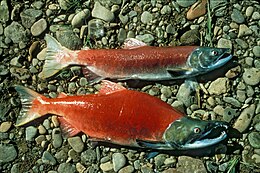Oncorhynchus
|
Oncorhynchus Temporal range: Late Miocene - Recent |
|
|---|---|
 |
|
|
Sockeye salmon, Oncorhynchus nerka Female (above) and male in mating season Note male with kype (hooked snout) |
|
| Scientific classification | |
| Kingdom: | Animalia |
| Phylum: | Chordata |
| Class: | Actinopterygii |
| Order: | Salmoniformes |
| Family: | Salmonidae |
| Subfamily: | Salmoninae |
| Genus: |
Oncorhynchus Suckley, 1861 |
| Type species | |
|
Oncorhynchus gorbuscha (Walbaum, 1792) |
|
| Species | |
Oncorhynchus is a genus of fish in the family Salmonidae; it contains the Pacific salmon and Pacific trout. The name of the genus is derived from the Greek onkos ("hook") and rynchos ("nose"), in reference to the hooked jaws of males in the mating season (the "kype").
Salmon and trout with native ranges in waters draining to the Pacific Ocean are members of the genus. Their range extends from Beringia southwards, roughly to Taiwan in the west and Mexico to the east. In North America, some subspecies of O. clarki are native in the Rocky Mountains and Great Basin, while others are native to the Rio Grande and western tributaries of the Mississippi River Basin which drain to the Gulf of Mexico, rather than to the Pacific. Several species of Oncorhynchus have been introduced into non-native waters around the globe establishing self-sustaining wild populations.
The six Pacific salmons of Oncorhynchus are anadromous (migratory) and semelparous (die after spawning). Migration can be affected by parasites. Infected individuals can become weak and probably have shortened lifespans. Infection with parasites creates an effect known as culling whereby fish that are infected are less likely to complete the migration. Anadromous forms of Oncorhynchus mykiss known as steelhead are iteroparus. The Coastal cutthroat trout form of Oncorhynchus clarki is considered semi-anadromous as it spends short periods of time in marine environments.
...
Wikipedia
